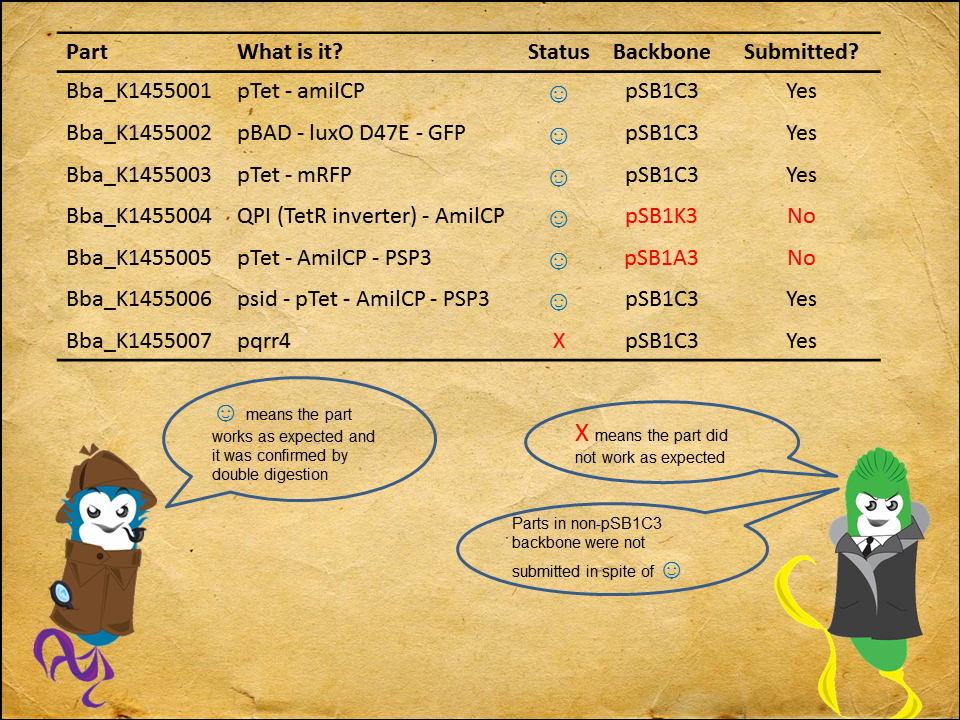Team:Colombia/Parts
From 2014.igem.org
| (5 intermediate revisions not shown) | |||
| Line 11: | Line 11: | ||
<font size="4" >In the following table you can find the parts we built (all of them are RFC10 compatible). You can check each one in our <a href="http://parts.igem.org/cgi/partsdb/pgroup.cgi?pgroup=iGEM2014&group=Colombia" target="_blank"> offical part's submission page</a>, where you also can find their documentation and characterization. </font><br><br> | <font size="4" >In the following table you can find the parts we built (all of them are RFC10 compatible). You can check each one in our <a href="http://parts.igem.org/cgi/partsdb/pgroup.cgi?pgroup=iGEM2014&group=Colombia" target="_blank"> offical part's submission page</a>, where you also can find their documentation and characterization. </font><br><br> | ||
</html> | </html> | ||
| - | [[File:BioPArtsColombia.jpg|center| | + | [[File:BioPArtsColombia.jpg|center|600px]] |
<html> | <html> | ||
<br><br> | <br><br> | ||
| - | < | + | <p> |
| - | + | We constructed 7 new, RFC10-compatible parts, two of which were not submitted to the registry because we could not transfer them to the appropriate plasmid backbones on time. Among the parts we built are two reporter genes under the control of <i>ptet</i>. One of these was used to build two different versions of the output circuit: one version with <i>psid</i>, thus completing the feedback loop, and another stand-alone version without the inducible promoter. We also built a circuit capable of producing phosphorylated LuxO when induced by arabinose to test the signal processing and output circuits. Additionally, we built our own Quad-Part tetracycline Inverter device, because we found the one in our distribution to be faulted. We also built a <i>pqrr4</i>-containing biobrick; this part, however, did not appear to function as expected. Finally, since we cannot work with actual <i>V. cholerae</i> due to obvious biosecurity concerns, we need a way of testing the circuits we build without having to deal with the pathogen. For this reason, <i>cqsA</i> was cloned in <i>E. coli</i> (BBa_K581011) to use as a positive control for the whole system. | |
| - | + | </p> | |
| - | + | <br><br> | |
| + | <br><br> | ||
| + | <br><br> | ||
</html> | </html> | ||
Latest revision as of 00:44, 18 October 2014
Parts
In the following table you can find the parts we built (all of them are RFC10 compatible). You can check each one in our offical part's submission page, where you also can find their documentation and characterization.
We constructed 7 new, RFC10-compatible parts, two of which were not submitted to the registry because we could not transfer them to the appropriate plasmid backbones on time. Among the parts we built are two reporter genes under the control of ptet. One of these was used to build two different versions of the output circuit: one version with psid, thus completing the feedback loop, and another stand-alone version without the inducible promoter. We also built a circuit capable of producing phosphorylated LuxO when induced by arabinose to test the signal processing and output circuits. Additionally, we built our own Quad-Part tetracycline Inverter device, because we found the one in our distribution to be faulted. We also built a pqrr4-containing biobrick; this part, however, did not appear to function as expected. Finally, since we cannot work with actual V. cholerae due to obvious biosecurity concerns, we need a way of testing the circuits we build without having to deal with the pathogen. For this reason, cqsA was cloned in E. coli (BBa_K581011) to use as a positive control for the whole system.
 "
"






